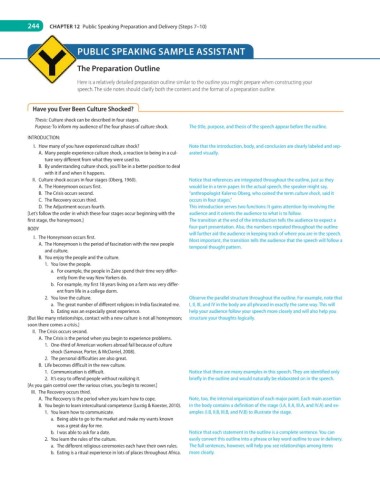Page 265 - Essentials of Human Communication
P. 265
244 Chapter 12 Public Speaking Preparation and Delivery (Steps 7–10)
publIC SpeakIng Sample aSSIStant
the preparation Outline
Here is a relatively detailed preparation outline similar to the outline you might prepare when constructing your
speech. The side notes should clarify both the content and the format of a preparation outline.
have you ever Been Culture shocked?
Thesis: Culture shock can be described in four stages.
Purpose: To inform my audience of the four phases of culture shock. The title, purpose, and thesis of the speech appear before the outline.
INTRODUCTION:
I. How many of you have experienced culture shock? Note that the introduction, body, and conclusion are clearly labeled and sep-
A. Many people experience culture shock, a reaction to being in a cul- arated visually.
ture very different from what they were used to.
B. By understanding culture shock, you’ll be in a better position to deal
with it if and when it happens.
II. Culture shock occurs in four stages (Oberg, 1960). Notice that references are integrated throughout the outline, just as they
A. The Honeymoon occurs first. would be in a term paper. In the actual speech, the speaker might say,
B. The Crisis occurs second. “anthropologist Kalervo Oberg, who coined the term culture shock, said it
C. The Recovery occurs third. occurs in four stages.”
D. The Adjustment occurs fourth. This introduction serves two functions: It gains attention by involving the
[Let’s follow the order in which these four stages occur beginning with the audience and it orients the audience to what is to follow.
first stage, the honeymoon.] The transition at the end of the introduction tells the audience to expect a
BODY four-part presentation. Also, the numbers repeated throughout the outline
will further aid the audience in keeping track of where you are in the speech.
I. The Honeymoon occurs first. Most important, the transition tells the audience that the speech will follow a
A. The Honeymoon is the period of fascination with the new people temporal thought pattern.
and culture.
B. You enjoy the people and the culture.
1. You love the people.
a. For example, the people in Zaire spend their time very differ-
ently from the way New Yorkers do.
b. For example, my first 18 years living on a farm was very differ-
ent from life in a college dorm.
2. You love the culture. Observe the parallel structure throughout the outline. For example, note that
a. The great number of different religions in India fascinated me. I, II, III, and IV in the body are all phrased in exactly the same way. This will
b. Eating was an especially great experience. help your audience follow your speech more closely and will also help you
[But like many relationships, contact with a new culture is not all honeymoon; structure your thoughts logically.
soon there comes a crisis.]
II. The Crisis occurs second.
A. The Crisis is the period when you begin to experience problems.
1. One-third of American workers abroad fail because of culture
shock (Samovar, Porter, & McDaniel, 2008).
2. The personal difficulties are also great.
B. Life becomes difficult in the new culture.
1. Communication is difficult. Notice that there are many examples in this speech. They are identified only
2. It’s easy to offend people without realizing it. briefly in the outline and would naturally be elaborated on in the speech.
[As you gain control over the various crises, you begin to recover.]
III. The Recovery occurs third.
A. The Recovery is the period when you learn how to cope. Note, too, the internal organization of each major point. Each main assertion
B. You begin to learn intercultural competence (Lustig & Koester, 2010). in the body contains a definition of the stage (I.A, II.A, III.A, and IV.A) and ex-
1. You learn how to communicate. amples (I.B, II.B, III.B, and IV.B) to illustrate the stage.
a. Being able to go to the market and make my wants known
was a great day for me.
b. I was able to ask for a date. Notice that each statement in the outline is a complete sentence. You can
2. You learn the rules of the culture. easily convert this outline into a phrase or key word outline to use in delivery.
a. The different religious ceremonies each have their own rules. The full sentences, however, will help you see relationships among items
b. Eating is a ritual experience in lots of places throughout Africa. more clearly.

